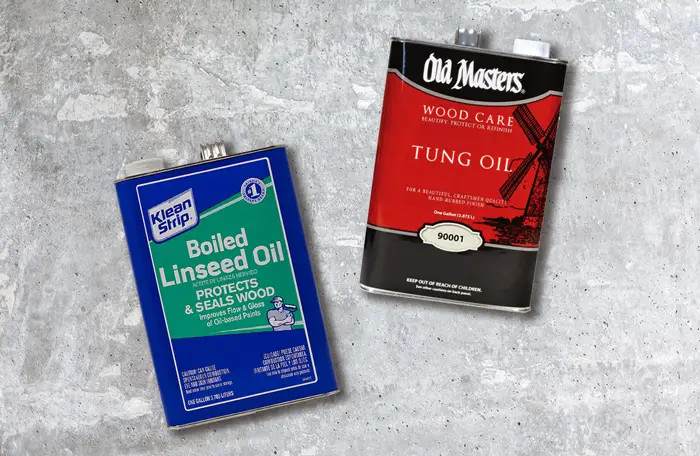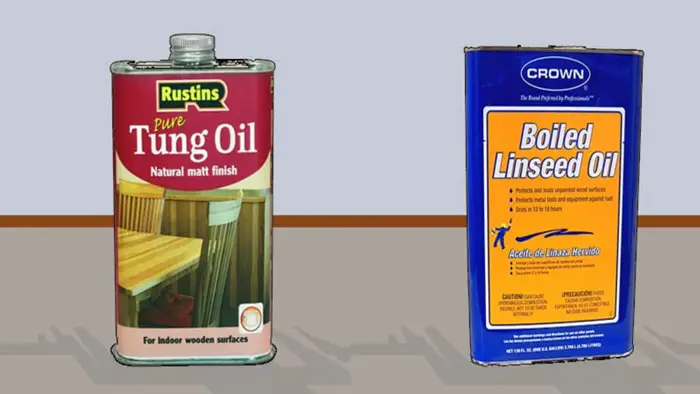Tung Oil Vs Linseed Oil: What Are Their Differences?
Regarding wood finishes, some of the popular choices that might get you mixed up are tung oil and linseed oil. Both are excellent natural options but have distinct properties worth considering for your project.
Then, what are the differences between tung oil vs linseed oil? Tung oil dries much faster than linseed oil, typically taking 2-3 days to fully cure versus weeks for linseed oil. It also produces a more water-resistant finish and less yellowing of the wood grain. Additionally, tung oil results in a matte sheen, while linseed oil leaves a satin finish.
Understanding the differences will help you select the finish best suited to achieve the look and level of protection your furniture or woodworking needs.
A Table Of The Differences Between Tung Oil And Linseed Oil
Here is a table highlighting the major differences between tung oil and linseed oil at a glance.
| Aspect | Tung Oil | Linseed Oil |
|---|---|---|
| Source | Extracted from nuts of tung tree | Derived from flaxseeds |
| Appearance | Clear, matte finish | Amber-yellow tint, becomes more saturated |
| Water Resistance | High water resistance | Limited water resistance |
| Versatility | Suitable for high-traffic surfaces | Best for decorative or touch-up use |
| Care and Cleaning | Easily wiped with damp cloths | Delicate cleaning with solvents required |
| Durability | Highly durable and scratch-resistant | Less durable, needs frequent reapplication |
| Application and Cure Time | Straightforward, faster drying | Straightforward, slower drying |
| Price | Generally more expensive | Generally cheaper |
What Are The Differences Between Tung Oil And Linseed Oil?
Tung oil and linseed oil have distinct qualities that make them better suited for certain applications. Here is a closer look at these differences:

Their Source
Tung oil comes from the fruit of the tung tree, which is native to China. The fruit contains small oval nuts crushed to extract the tung oil.
On the other hand, linseed oil comes from flaxseeds, which are the seeds of the flax plant. Flaxseed oil has been used for centuries as a finish for wood and other materials.
Appearance
Pure tung oil provides a clear, matte finish that allows the natural color and grain of the wood to shine through, imparting minimal hue changes.
In contrast, linseed oil lends an amber-yellow tint to the wood that becomes progressively more yellow and saturated over time. This hue change is particularly noticeable on lighter woods like maple and birch.

Water Resistance
There is a stark contrast in water resistance between the two oils. Tung oil penetrates deeply into the wood pores and polymerizes upon exposure to oxygen and UV light. That forms a tough, water-resistant barrier.
Conversely, linseed oil does not penetrate as deeply or harden considerably upon curing. Therefore, linseed oil provides only minimal protection against moisture ingress and wet damage to wooden surfaces.
Versatility
Both tung oil and linseed oil have applications across a range of wooden surfaces. Tung oil can be used on high-traffic furniture, wood floors, boat decks, and wood musical instruments.
Linseed oil is suitable for decorative wooden bowls, cutting boards, and ornamental furniture but is not durable enough for regularly used surfaces.
In general, linseed oil is best utilized as a touch-up oil on wood finished with other products. Tung oil, on the other hand, offers more versatility as a standalone finish for high-performance applications.
Care and Cleaning
Tung oil-finished wood surfaces can be easily wiped clean with a damp cloth. For tougher cleaning tasks, mild soap, water, and some household cleaners can also be used.
Linseed oil-finished surfaces require more delicate cleaning with solvents like turpentine or vinegar to avoid damaging the oil film. Too much moisture can break down the linseed oil finish.

Durability And Maintenance
When properly applied, tung oil penetrates deeply into the wood’s pores to form a durable, hardened film upon curing. As a result, finishes with tung oil exhibit high durability, scratch resistance, and water resistance.
When it comes to linseed oil, it only forms a superficial oil film on the wood that offers minimal durability and scratch resistance. Linseed oil finishes also wear down faster and need to be reapplied more frequently, often yearly.
Application
Pure tung oil is easy to apply, requiring minimal effort. The application process involves simply sanding the wood smooth, removing all dust, and then flooding the surface with the tung oil.
As dry spots appear, more oil can be added. Once the wood no longer absorbs any more oil, the surface is wiped clean with a dry cloth.

The same process applies to raw linseed oil, though after applying it and allowing it to penetrate the wood for 15 minutes, the excess oil is wiped off. If the surface dries considerably within 15 minutes, the wood is allowed to absorb more oil before wiping clean.
Dry and Cure Time
Tung oil dries and cures much faster than linseed oil, making it more practical for DIYers and homeowners. It takes 2 to 3 days to cure after application, after which subsequent coats can be applied.
On the other hand, raw linseed oil takes several weeks to fully cure and harden between coats. This substantially longer drying time makes linseed oil finish impractical for most people. However, boiled and polymerized versions of linseed oil dry faster but compromise other properties like non-toxicity.
Price
Generally, raw linseed oil is cheaper than pure tung oil, costing around $15 to $20 per quart compared to $25 to $30 per quart for tung oil. However, boiled linseed oil and other modified versions can be priced competitively with impure tung oil products that contain additives and driers.
Tung Oil Vs Linseed Oil: What’s The Best Oil To Use On Wood?

When you compare natural tung oil with raw linseed oil, tung oil takes it in almost all aspects. It produces a superior finish for wood compared to linseed oil.
- The thicker, harder film that tung oil creates upon curing results in a finish that is more durable, water-resistant, and long-lasting.
- Tung oil remains the better choice for high-traffic and high-performance surfaces like furniture, countertops, and flooring that demand protective qualities.
- Given its fast dry time and ease of application, tung oil also presents a more practical finishing option for most DIYers and hobbyists.
- When it comes to aesthetics, the oil produces a clear, matte finish that allows the natural beauty of the wood to shine through with minimal color changes.
That makes tung oil an excellent choice for applications with a desired transparent, natural look.
- Tung oil-finished wood tends to last longer before requiring reapplication compared to linseed oil.
- While raw linseed oil offers a more budget-friendly option, the performance disadvantages relative to tung oil generally outweigh the lower price point.
So, it’s safe to say that for most wood finishing applications, tung oil delivers a superior combination of aesthetics, durability, ease of use, and care. It makes the better choice compared to linseed oil in most scenarios.
When considering the choice between tung oil and linseed oil for your woodworking projects, it’s essential to understand their characteristics and benefits. If you’re curious about the potential consequences of skipping the sanding step between coats of polyurethane, our article on what happens if you don’t sand between coats of polyurethane provides valuable insights into the impact on your finish’s quality and durability. Additionally, if you’re planning to apply polyurethane to your floors, our detailed guide on how to apply polyurethane to floors offers step-by-step instructions for achieving a flawless finish that enhances the beauty and protection of your wood surfaces. Explore these articles to make informed decisions for your woodworking projects.FAQs
Do you still have some burning questions about the differences between tung and linseed oil? Check these FAQs below.
Q: Is Linseed Oil Toxic?
Linseed oil is non-toxic and food-safe in its pure, raw form. However, boiled linseed oil sold in stores contains metallic driers that make it toxic. It is best to use only pure linseed oil and allow ample time to fully cure before use.
Q: Is Tung Oil A Permanent Finish?
No. Tung oil creates a very durable protective finish but is not fully permanent. It will require periodic reapplication to maintain its best water resistance and appearance over time. Left untouched, a tung oil finish can last many years before signs of wear necessitate reapplication to refresh the surface.
Q: Can I Put Tung Oil Over Linseed Oil?
Yes, you can apply tung oil over an existing linseed oil finish. Tung oil will bond well to the cured linseed oil and provide improved water resistance. However, fully prep the linseed oil surface with sanding before applying so the tung oil can adequately adhere.
Conclusion
No matter the project, a few key differences between tung oil vs linseed oil need to be understood. Tung oil provides a superior finish for wood surfaces. It has outstanding protection against water and damage, is easy to apply, and has fast drying times.
Linseed oil, on the other hand, is generally cheaper but is not suitable for high-traffic surfaces and requires delicate cleaning with solvents. When it comes to wood finishes, tung oil is the best choice for most woodworking projects due to its fantastic properties that ensure it stands the test of time.




